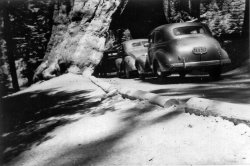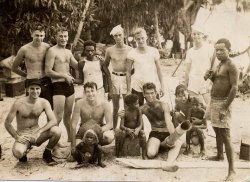
MAY CONTAIN NUTS

Search Shorpy
SHORPY ART

Framed or unframed, desk size to sofa size, printed by us in Arizona and Alabama since 2007. Explore now.
Join and Share
Ad-Free Shorpy
Shorpy is funded by you. Patreon contributors get an ad-free experience.
Learn more.

Recent comments
- Freeze Frame
- Texas Flyer wanted
- Just a Year Too Soon
- WWII -- Replacing men with women at the railroad crossing.
- Yes, Icing
- You kids drive me nuts!
- NOT An Easy Job
- I wonder
- Just add window boxes
- Icing Platform?
- Indiana Harbor Belt abides
- Freezing haze
- Corrections (for those who care)
- C&NW at Nelson
- Fallen Flags
- A dangerous job made worse
- Water Stop
- Passenger trains have right of way over freights?
- Coal
- Never ceases to amaze me.
- Still chuggin' (in model form)
- Great shot
- Westerly Breeze
- For the men, a trapeze
- Tickled
- Sense of loneliness ...
- 2 cents
- Charm City
- What an Outrage
- Brighton Park
Member Photos
The Shorpy
Print Emporium
Print Emporium
Search Shorpy
Search results -- 30 results per page
- End of the Road: 1966
- ... and my brother's college; took us on our first visit to Yosemite, and later our very first camping trips (see our decals?); took my ... Posted by tterrace - 01/28/2012 - 5:12pm -
![End of the Road: 1966 If you think this is just a photo of a well-worn old car, you're wrong. It's actually a significant moment in our family's history. June 27, 1966 was the last day for our 1956 Hudson Rambler. Previously, we saw it all shiny and sparkly, mere days after we got it. During the following ten years, it: took my sister to the church for her wedding; took us to graduations, my grade and high school and my brother's college; took us on our first visit to Yosemite, and later our very first camping trips (see our decals?); took my folks to visit their first grandchild; and perhaps most important of all, took me to my first visit to Disneyland.
I decided to record the event in a series of Ektachrome slides. Here, my father is clearing out all our personal items prior to the trip to the dealer to pick up our new car - a 1966 Rambler Classic station wagon. Oh; our trade-in allowance for this one: $50. View full size.
I love the colors on that car!Colors in the 1950s were wonderful, today everything is a shade of brown or gray.
My childhood car was a white 1965 Plymouth Belvedere four door. Purchased new by my dad, it was the most stripped down model available, three on the tree, AM radio, vinyl seats, Canadian built 318, and no AC.
UglyMan, that is one ugly car.
Of course, I can't talk: in the 60's my folks didn't even have a car - and we lived in a way outer outer suburban area. So outer suburban that we didn't even have a made road, our street was a collection of potholes loosely joined together with gravel.
Our family's first car was an Austin A50 "ute" (pickup) with wooden floorboards in the back.
Romney connectionWell, Hudson merged with Nash-Kelvinator to form American Motors, and George Romney (Mitt's dad) became president of AMC in 1954.
Not a bad looking car, in my opinion. I'm sure a lot of happy memories were associated with it. Reminds me of the great "Wonder Years" episode where the Arnold family are prepping their memory-laden station wagon for sale.
StrangeThat fellow doesn't look like Chevy Chase.
They don't make 'em like this anymoreWas it like that episode of The Wonder Years?
Be still my heartOooh. My Edsel and Studebaker would love to share their driveway with that car. You just don't see many of those today, even at car shows. Hope it had power steering and an automatic transmission. Too much to ask for it to have air conditioning too. I'm pretty sure it did not.
Where is that time machine when you need it? It probably sold for less than one day's wages in today's money.
[How IS that Edsel of yours. Pic? - Dave]
Product LoyaltyYour dad was like I have been, loyal to the make of car I drive. Like your dad, I made my way from a Detroit built Hudson "Step-Down" and on to American Motors products built at the old Nash factory in Kenosha, Wisconsin. All were well built cars and doggedly reliable.
Thanks tterrace for another glimpse into your fine family's interesting history.
My family car in June 1966 was ...This 1960 Edsel. My father bought it new for my mother to drive me in the kindergarten carpool. Thankfully my father never traded in any car we had, ever, so I still have it.
This pseudo vintage photo of it was taken August 30 2011, at Center Studios in Los Angeles. It, and the other cars on the street, were working on a TV program set in 1966 that night.
In answer to your question Dave, the car is in turn key condition. It has about 300,000 miles on it and is never trailered.
Don't you agree that the green Hudson wagon, with its white roof, would look real good in the driveway next to it?
[My first (and only) 1960 Edsel encounter was circa 1977 in Lake City, Florida. It was parked tail-out in an alleyway, and as it loomed into view I remember thinking "What the hell IS that?" I considered myself to be a car guy but had never seen anything like this -- it looked like the mutant offspring of a 1960 Ford and Little Orphan Annie. The rear end is, to put it mildly, unique. - Dave]
The way cars were meant to be builtThe bodies for these cars were built in Milwaukeen at the old Seaman Body Division of the Nash-Kelvinator Corp., on North Richards Street. They were trailered south to Kenosha for drive assemblies, interiors, etc. My car-freak friends and I witnessed hundreds and hundreds (thousands?) of car bodies heading down 27th Street (Highway 41) on their way to Kenosha. The 1956 Rambler was pretty much the design work of Edmund Anderson, the first design chief Nash ever had. By 1956 George Romney was in charge at AMC, and bet the whole farm, with mixed results, on the small car niche. I believe one of the engines offered in this car was a 262 cubic inch inline 6, with 7 (yes, seven!) main bearings. With proper maintenance one could be driving a 56 Rambler yet.
Design stops at the rear wheelsEverything to the front of the rear axle is sculpted; everything to the rear is extruded.
Miss the colorsI agree with Vintagetvs. I miss the shiny chrome, bright vivid colors and bold distinctive designs of the '50s. Today's cars may be full of hi-tech electronics but they are drab and monotonous on the outside.
Oooh! That's a grand carAnd so was the '66 Rambler Classic! I grew up with the 66 four door at the turn of the 70's and even slept with the whole family with the front seats reclined to join with the back on a rainy camping trip. What American design genius!
The white roofInteresting factoid about the white roof on our Rambler wagon: that's not the way it came from the factory. Originally the car was solid green; the dealership talked my father into having them paint the roof, pointing out it would keep the car cooler inside. I remember it chipping slightly around the edges, and I was never able to get a good shine on it like the factory paint.
Later that day, our new Rambler (Larry Brink Motors, Mill Valley, Calif.), ready to drive home:
Car trade insI vividly remember accompanying my late father when we took our '55 Chevy from Madison, Wisconsin to a nearby town to trade it in on a brand new '59 Chevy wagon. He said nothing at the time, but for years afterward complained that his impulse at the time was to take the wagon back for the '55. Too bad, because the wagon proved to be pretty awful, requiring numerous, expensive repairs. That damaged his brand loyalty for a long time, though he never joined the mass of his friends by purchasing a Japanese car. Pretty much a buy-American guy except for one area. When I returned from overseas service in the Army, there was a brand new Sony TV in the house, a quantum leap ahead of the dreadful American sets we had endured before. I'm utterly amazed that I don't recall any wagons like that Hudson. I remember the older slope backed ones, Studebakers, Kaisers and the rolling refrigerator-like Nash Metro though.
1960 EdselI too apparently have somehow escaped seeing a 60 Edsel before now, or at least I didn't notice, I had to Google it to see the back end.
The front is really quite attractive and "normal," but the back got an extra helping of weird!
Our 1959 Cross Country RamblerA photo of me and my younger brother in Mamaroneck, NY 1961. He always wanted to ride in the rear, facing backwards.
When I was 21, it was a very good yearThis was my ride in 1958, a '54 Studebaker Starliner hardtop coupe, shown in the one photo with my friend Roger Baxter's chopped '48 Mercury. The Starliner (by Robert Bourke, a Raymond Loewy associate) has consistently been ranked as one of the best-designed cars of that era. Mechanically it was not a winner but oh those lines. I dropped a small block Chevy engine in it with a Chevy overdrive transmission, lowered it by torching the springs, and transformed a poorly-handling slow car into a seriously poorly-handling fast car. The color photo shows it after I dechromed it, painted it Chinese red, and slapped on a set of Moon aluminum wheel covers, just like they used then at Bonneville. (I was a dreamer.) My next car was a 1960 Austin Healey 3000. Photos taken on the Jaffa Mosque (!!!) lot, Altoona, Pa.
I'm confusedWe had a 1953 Nash Rambler in our family in the 60s. When did the Nash/Hudson change take place? Was there a period when they were both using the Rambler marque? I'm pretty sure ours was pre-AMC.
Maybe one of you Shorpycar experts can set me straight.
It was a 4 door sedan and the front fenders looked the same as this one, although the grillwork was different. The taillights were exactly the same. It also had the very neat full reclining seats.
Speaking of color, ours was a most hideous shade of green similar to an Army olive drab, only uglier! It was, however, as sturdy as anything the Army had on hand. It had a quite strong in-line 6 and 3-on-the-tree.
...
Oops, sorry tterrace and Dave. Had I jumped to your other link I would have found my answer in the comments there.
That'll teach me!
Back o' the RamblerLike JD's little brother, I loved riding back there too, rattling around like a loose screwdriver in an empty toolbox, getting that vertigo-inducing backwards view through the roll-down window and getting slightly high on carbon monoxide. Great photo op angle, too.
Check out my '57 Ford FairlaneThis was the first new car I ever owned, bought with a loan cosigned with my Dad. It cost us $2300 and was worth every penny of that. It came without a radio, so I bought one. Its cable was very short, so I had to install it upside down for the fit into the dash. That confused a lot of my friends. I drove that car for about 18 months, but then sold it to a coworker when I accepted a job in Manhattan and moved into the City. Within two months, he 'totalled' it in an accident somewhere between Plainfield NY and Brooklyn. I still miss that car.
Rambler/Hudson connectionIn 1954, Nash bought Hudson to form American Motors. The head of AMC, George Mason, died shortly after the merger and his second in command, George Romney, took over. The warmed over "step down" Hudsons were deleted and their new small car, the Hudson Jet, didn't sell in big numbers and was a potential threat to the 100 inch wheel base Nash Ramblers.
From 1955 to 1957, Hudsons were rebadged Nashes with some extra doodads and Hudson dashboards. The Rambler was essentially the same, as I have the pie pan hubcaps from my '58 with the "R" in the middle instead of the "H". Romney decided to concentrate on the Rambler line for '58 with no more Hudson or Nash nameplates, and it proved to be a wise decision as they made lots of profit and even beat Chrysler out in auto production in the early '60s, before Romney left to be governor of Michigan.
For many years, the Rambler Station Wagon was about 40 percent of their production. The little slope in the back roofline was due to welding the extra length of metal to the sedan roof, as they didn't have large enough stamping machines for a one-piece wagon roof. The addition of the chrome luggage carriers made the roofline more straight.
The engine for most Ramblers was the 195.6 straight six which evolved from the earlier Nash "Flying Scot" engines.
Romney was asked if it bothered him that most Ramblers were in the slow lane when it came to roads. He responded that it didn't bother him as long as there were a lot of them.
BTW, AMC was the only company to bring back a car from the dead. In 1958, they had the dies from the old 100-inch-wheelbase Ramblers, and slightly remade the car and put it out as the Rambler American to sell with the 108 inch "larger" Rambler.
On the Other SideWell gee Dave, now everybody is going to be wondering "what did Dave see on the rear of that car?" So here is what Dave is talking about, the rear of a 1960 Edsel.
TransposedWhen I was a kid my grandmother owned a Rambler. On the front grille the word "Rambler" was supposed to be displayed, but it was placed as R A M B E L R. True.
Those were the daysI agree, they knew how to design cars in the '50s and '60s. That's why I bought a Chevy 210 in Lake Tahoe some years ago and shipped it to the Netherlands.
Great pictures by the way (as always).
Keep 'emI'm not too sure I could take my old car in for a trade. I still have my first new car, a 1971 Toyota Land Cruiser. Just before it was due to change over to 400,000 miles, the odometer broke (third engine).
Ah, Ramblerstterrace, your parents' '66 Classic wagon pictured below sits in front of a car that looked just ours - a Frost White '66 American 4-door sedan. Ours was the high-line 440 model, with the all the brightwork that was missing on the cheaper 220. It had the 232 2-bbl Commando Six, a "Shift Command" (Borg-Warner) three-speed automatic, factory air conditioning, and pushbutton AM radio.
Ours came from Marty R's Roundup Rambler, in the Pleasant Grove section of Dallas. I can remember going with my dad to pick up the car. We had no trade-in, since the Ultramatic transmission in our '52 Packard Mayfair had gone out the year before. For several months, travel meant borrowing cars or bumming rides, while my parents saved up for the down payment.
Fifty BucksAs an avid S.F. Bay Area car-kid born in 1962 I remember seeing old used cars such as your dad's '56 Hudson-Rambler, in places like Berkeley and San Francisco, being used by college-aged kids as their daily transportation. These old cars lined the streets around campus, beaten by years of hard use and on their final decline before the scrap yard. Your dad's '56 wagon could have gone on to become a college kid's cheap wheels before succumbing to the pressure of 'planned obsolescence.' I seem to remember Hunter S. Thompson bought a new Rambler back in the late '50s or early '60s, he had nothing but trouble with it, and one of his books contains letters to the manufacturer over his car's ailments. Seeing your dad's ten-year old '56 makes me think of all the well-worn old cars around when I was a kid in the late 1960s.
(ShorpyBlog, Member Gallery, tterrapix)](https://www.shorpy.com/files/images/endoftheroad_0.thumbnail.jpg)
- How to Dress for School: 1955
- ... you look adorable.
[There's no snow in the Sierras, Yosemite, etc.? - Dave]
Brrr "The coldest winter I ever spent was a ... Posted by tterrace - 06/24/2009 - 5:11pm -
![How to Dress for School: 1955 My mother made darned sure I was bundled up enough for this (presumably) chilly late winter morning in early 1955. My brother shot this on Ektachrome in our front yard as I was about to set off on my 5 block walk to my third grade class at Larkspur-Corte Madera School. I can't remember what the theme of my lunchbox was. It was either "weapon against bullies on my way home" or "please don't let my Thermos break again." View full size. Later on: This and That.
Somewhere tropical?I see leaves on the bushes and no snow. Can't be that cold...
[Maybe it's one of those exotic "evergreens." This is in the jungles of northern California. - Dave]
What I want for Christmas...I just have to know... did you ever get that official Red Ryder carbine-action 200-shot range model BB gun with a compass in the stock? Or did you shoot your eye out?
My goodness, Peter Billingsley and you could have been brothers or at least cousins. You also resembled a young Robin Gibb.
I also can deeply relate to the over-protective mother bundling up the kids so tightly that they cannot move and you can't fight off the bullies because you can barely breathe.
California is COLD in the winter!Just because our families left snow country doesn't mean we don't have winter--it's just a different kind of winter!
And tterrace, you look adorable.
[There's no snow in the Sierras, Yosemite, etc.? - Dave]
Brrr"The coldest winter I ever spent was a summer in San Francisco"
-- Apocryphal Twainism
I think that about says it all.
Love the hat!I started school in 1960. In our district girls had to wear dresses or skirts and boys had to wear regular pants. No "dungarees".
Did you take the hat off when you got far enough away from the house?
Well you should have!
The ThermosI laughed so hard . I had forgotten how many of those stupid glass thermos mugs I broke as a child (born in 1951 so I know of what you speak) and how frustrated my mother must have gotten. It really didn't matter if it was in the lunchbox; it still got hammered, mostly because we couldn't resist swinging the thing around while we twirled in a circle like a governor or spun the box on a finger and sooner or later it slid off and...well, you know the rest.
After a while Mom gave up on the thermos mugs and sent me to school with money for milk, hopefully with the extra 2 cents (3 for white, 5 ...) for CHOCOLATE!
Flap-HappyYeah. Earflaps in the Bay Area might be going a little far, but it gets pretty nippy for sure. Of course, there can be many feet of snow in the Sierra Nevada mountain passes, but not many folks live up there year-round, unless their last name is Donner.
(ShorpyBlog, Member Gallery, Kids, tterrapix)](https://www.shorpy.com/files/images/schoolboy_.thumbnail.jpg)
- Brand New: 1938
- ... out some of the photos I submitted, mostly the ones from Yosemite Park, plus a different one my grandma is leaning on. Really awesome ... Posted by Dave - 07/17/2012 - 10:24pm -
![Brand New: 1938 November 23, 1938. Washington, D.C. "Ford Motor Co., Union Station." For the 1939 model year, Ford debuted a new brand called Mercury. View full size.
Preston and EliotI think I see Preston Tucker and Eliot Ness discussing the features of this Merc. See, they're right there in the middle of the two cars wearing the sharp suits and fedoras (and Tucker with an overcoat).
Mercury 8
Have you seen the most talked about
car in America?
(click to enlarge)
Shops there nowThat area of Union Station is now filled with two levels of mall shops:
http://www.flickr.com/photos/chaosandcosmos/1662509539/
The Bowery Boys!What is Huntz Hall looking at in the back seat of the Merc?
Now That's a BeautyAny juvenile lusting we boys have expressed for the feminine beauties that have appeared on Shorpy is nothing compared with our desire for that '39 Ford.
Missing! Hey, I'm an old-timer, but I can't imagine driving a car without outside rear-view mirrors!
Strangely EmptyIt looks like Union Station was under renovation when this display was mounted, it looks very empty at this point.
[There are more people (at least three more) than you might think in this time exposure. Similar to this seemingly depopulated photo of the same space. - Dave]
That signHeck with the cars -- I'm really into that "restaurant" sign.
I'll take the Merc!In marooon, please. With whitewalls!!
My dad was a real car buff, and he used to talk a lot about these big cars. I'm sure he would've loved to see one of these parked in his garage! (and me, too!) He used to tell me that his first car was precisely a Mercury, vintage 1946 or 1947, bought used in the late '50s, after he married my mom. Pretty much the same body shell as these, but with different grille. It's great seeing how they looked when new, definitely attractive cars!
Crazy 'bout a MercuryWell if i had money
Tell you what I'd do
I'd go downtown and buy a Mercury or two
Crazy 'bout a Mercury
Lord I'm crazy 'bout a Mercury
I'm gonna buy me a Mercury
And cruise it up and down the road
Grandpa had oneCheck out some of the photos I submitted, mostly the ones from Yosemite Park, plus a different one my grandma is leaning on. Really awesome cars.
https://www.shorpy.com/node/5237
I like the ForDor!Never seen a sign for a "fordor" car "befor" - so now I see that there is a sedan with tudor, and the fordor with four. Nothng to do with Mordor I trust.
is a fordor with mordors a fivedor?
Sweet shape, anyway,
Lou
AliquippaThe car in the middle of the dismal Aliquippa winter pic
https://www.shorpy.com/node/6125
is a '39 Merc. Recognizable immediately from the rear by its weird sideways-pointing taillights. No car before or since had them.
Newman's ownThe guy in the middle with his hands in his pockets looks just like Paul Newman.
Do they take rubles forThe Ford Fordor Dostoyevsky?
Tudor FordorFord continued with that Tudor/Fordor business up until the early 1950s, so they must have thought it had some marketing value. As a car-crazy kid, already in my precocity aware of the true meaning of "Tudor," I thought it was incredibly lame.
[The name cried out for a half-timbered station wagon. - Dave]
Looks more likePaul Newman than Paul Newman does. I still can't get over the locomotive weighing 90 times an automobile of that day.
The Runaway Federal!This photo was taken about 100 feet from the place (Track 16) where the runaway train #173 crashed through the gates shown in the background and proceeded to fall through the concourse floor on January 15, 1953. The 477,000-pound locomotive was cut into sections, removed from the basement and reassembled! I was in this area in 1970 before any major renovations, and you could plainly see where the floor had been repaired.
Dad's MercFirst car I remember was my dad's black 1939 Mercury convertible. Kept it through the war years and wouldn't put the top down for fear that it would crack or tear. Wish I had that car now.
Also went with my dad to see the locomotive that crashed through the Station floor in 1953. Brakes failed and it would only stop when it crashed through the floor.
(The Gallery, Cars, Trucks, Buses, D.C., Harris + Ewing, Railroads)](https://www.shorpy.com/files/images/25449a.thumbnail.jpg)
- The Boaters: Late 1930s
- I'd reckon this is the late 1930s in Yosemite. Yosemite seems to be where a lot of these travel pictures were taken. And I can ... Posted by Tony W. - 09/17/2011 - 8:13pm -
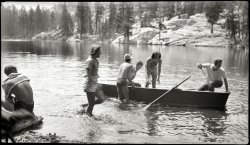
- Manzanar: 1943
- ... ago a photographer friend took an Adams workshop class at Yosemite. He said he was so in awe of Adams he could hardly remember what was ... Posted by Dave - 09/09/2011 - 12:30pm -
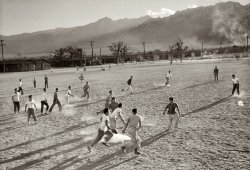
- Cafe Texaco: 1950
- ... encouraging me to visit. My fantasy has now shifted to Yosemite, Death Valley, and San Francisco, with Tom’s Place as the pretext ... Posted by Dave - 03/06/2021 - 4:32pm -
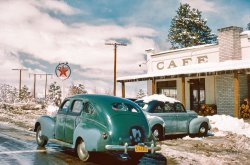
- Standardized: 1942
- ... kid of my generation and before whose family vacationed in Yosemite. -tterrace]
Brand loyalty There was brand loyalty back in ... Posted by Dave - 05/30/2015 - 12:57am -
![Standardized: 1942 June 1942. "Tracy, California. Gasoline filling station." With a Beauty Parlor for major overhauls. Photo by Russell Lee, Office of War Information. View full size.
Gas rationing?I was 8 years old when this picture was taken. Seeing no gas rationing stickers on the windows of the cars, I found this information:
"By the end of 1942, half of U.S automobiles were issued an 'A' sticker which allowed 4 gallons of fuel per week."
The Tracy InnThis photo was taken across West 11th Street, facing the Tracy Inn (constructed in 1927, and still in place). It was near the intersection of U.S. Highways 50 (once part of the 1915 Lincoln Highway, now I-205 Business) and 99A, and the West Side Highway (now State Route 33 north). The Standard Station itself has been replaced by a mixed-use building that houses, among other things, the Tracy Press. With most highway traffic now diverted around downtown Tracy, the number of service stations at this intersection has gone from three to zero.
[Riding through downtown Tracy is a memory of just about every Bay Area kid of my generation and before whose family vacationed in Yosemite. -tterrace]
Brand loyaltyThere was brand loyalty back in those days, too. I don't think price was the only criterion. The oil companies were early users of account cards, which is all you needed to fill the tank. My Dad had a Union Oil Company of California card and always sought out Union stations and their associates from 1946 to the late 1960s. I had a Mobilgas card, which also covered various kinds Standard Oil stations elsewhere in the country. Good for repairs, tires and batteries as well. You got a monthly bill in the mail, which you paid in full like an American Express Green card.
Gassy part of townThree gas station on three corners. I wish they would post the prices like they do today. It would be interesting seeing what they charged back then. I remember gas wars and prices of $.30 per gallon during my youth.
Another ViewOf yesterday's photo. The tanker that appears to be leaving was filling up the gasoline in-ground tanks.
As in the previous shotLove those old cab-overs.
Oil BottlesI don't miss the glass oil bottles, but sure miss the long spouts. It would really be nice today when oil fills are hidden by hoses, wires, and covers.
I Wasn't Around In '42But do remember the gas wars of the 50's and prices of 25 cents per gallon with a free set of glassware AND a clean windshield!
Detroit Gas WarsI had a 1967 VW beetle which I purchased new in 1967. For years I never spent more than $3.00 to fill its 10 gallon tank. The lowest gas prices I remember was 18.9 cents per gallon for Gulftane in the Detroit area.
Summer of '62I was a pump jockey that year, and pumped gas for 16 cents a gallon during a price war in OKC.
Those oil bottles -My best friend's dad owned and drove taxicabs in New York City as we were growing up in the late 50s and early 60s. I imagine that in an effort to be frugal, he would drain the oil and then filter it through cheesecloth or something similar, and then rebottle it for the next cycle. At least it filtered out the "big" stuff though it did not take care of oil that may have oxidized. He also had those wire carriers that held six bottles.
(The Gallery, Cars, Trucks, Buses, Gas Stations, Russell Lee)](https://www.shorpy.com/files/images/SHORPY-8c32171a1.thumbnail.jpg)
- California Ramblers: 1967
- ... looks more like Sequoia Natl Park or Kings Canyon, than Yosemite. Any chance you remember where you were?
And, T, those socks with ... Posted by tterrace - 06/06/2019 - 1:56pm -
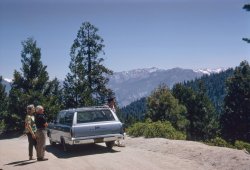
- Lenny and Edna: 1924
- ... had trapped her and her girl companion during a trip thru Yosemite valley, Miss Edna May Wilbur, daughter of Secretary of the Navy Curtis ... Posted by Dave - 08/13/2012 - 6:08pm -
![Lenny and Edna: 1924 June 3, 1924. "Leonard and Edna Wilbur," children of Navy Secretary Curtis Wilbur. National Photo Company Collection glass negative. View full size.
Edna & OnaFrom the Lima (Ohio) News, April 9, 1928:
Rescued by forest rangers from a narrow ledge 2,000 feet high, where darkness had trapped her and her girl companion during a trip thru Yosemite valley, Miss Edna May Wilbur, daughter of Secretary of the Navy Curtis D. Wilbur, was home here none the worse for her thrilling experience. Miss Wilbur went to the park with a party of friends. She and Miss Ona E. Ring attempted late Saturday to descend the snow-covered trail from Glacier point to the floor of the valley. Caught by darkness, they lost the trail and presently found themselves on the narrow ledge, whence they feared to attempt further progress. With a biting mountain wind tugging at their clothing, the girls huddled against the face of the cliff and called for help. Tourists in the valley, 2,000 feet below, heard their cries, and notified the forest rangers. Five men reached the girls shortly before midnight, and strenuous efforts succeeded in hauling them up to the trail with ropes.
[Thrilling! I think this was an episode of "Leave It to Beaver." - Dave]
Tats or Vacs?Those circular things on her arms. Can I assume that they were vaccination scars? She certainly has a modern attitude or so it seems.
[That's mold on the emulsion. - Dave]
Yes, DaveYes, the episode wherein the Beav climbs into a teacup and can't climb out and is rescued by the fire department. Amazing how daring Miss Wilbur was - that explains the dress.
[Not quite. I was thinking of the episode where Beaver and Gilbert go camping, get stuck on a ledge and are rescued by park rangers. - Dave]
Still waters run deepMiss Edna has a certain sly gleam in her eye. I'll bet she danced a few Charlestons in her time while Dad was off minding the boats.
Edna Does D.C.Atlanta Constitution, 11 July 1924
New Cabinet Daughter
Lands in Capital
And Looks it Over
Washington's newest cabinet daughter has been spending her first few days in the capital just like anybody's daughter here on an excursion trip -sightseeing.
Miss Edna Wilbur, whose father is secretary of the navy, arrived last Thursday from California. She came through the Panama canal with her brother, Leonard Wilbur, and then up the Chesapeake bay and the Potomac, from Hampton Roads, on the neat little yacht Sylph, which is at her father's disposal as boss of the navy.
...
Miss Wilbur is Washington's third cabinet daughter of marriageable or debutante age. Both the other two aren't braving hot weather here.
...
Miss Wilbur has another cabinet distinction besides braving Washington heat. She's the only daughter of a cabinet member who knows how it feels to spend money earned by herself.
The daughter of the navy secretary is a California high school teacher and she didn't give up her job just because her father is a member of President Coolidge's cabinet ...
Miss Wilbur is a tall girl, with much pale yellow hair and a fair skin. Not pretty, but attractive looking. And not the debutante or flapper type.
She is quiet and self-possessed. She has the voice and manner of a successful teacher.
And --no, her hair is not bobbed!
A Boston Globe article from April 13, 1924 says Edna graduated from Stanford with a degree in French. She was teaching at Chico High School.
Leonard or Lyman, perhaps Paul?I've been doing some research on Curtis Wilbur and all the sites list his children as Edna, Paul and Lyman. Perhaps Leonard was a nickname or is this a typo?
[Leonard Wilbur's name makes dozens of appearances in the historical archives of various newspapers. See the next comment up. - Dave]
Dr. Leonard Wilbur's mission Young Leonard would lead an inspiring, but all too short, life. After graduating from medical school at Stanford (where his uncle had been a president) he and his wife embarked upon a mission to Northern China, starting a hospital in the province now known as Shanxi. First the communist insurgents invaded (and the Wilburs were reported missing) in 1936. They resurfaced, but in late 1937 the Japanese invaded Shanxi (and the Wilburs were again reported missing but resurfaced). On Easter in 1940, during the Japanese occupation, Leonard died of typhus. He was only 33. His wife survived, and became one of the heirs to father-in-law Curtis Wilbur's inheritence when he died in 1954.
Sorry, Miss Edna.I guess you weren't the flapper I took you to be. The sly gleam must have been that look you gave your students to let them know you meant business.
Wilbur childrenCurtis D Wilbur had 5 children...
1. Ralph 3/18/1903 - 3/24/1906 age ~3
2. Leonard 3/2/1907 - 3/24/1940 age 33.
3. Edna was 25 in this photo, and Leonard 17.
From Pathways: A Story of Trails and Men (1968) by John W. Bingaman--
The Ledge Trail: "In 1871, James M. Hutchings had been guiding parties of hikers to Glacier Point over a most hazardous trail, which he had blazed up the Ledge and through the chimney and which climbed 3,200 feet in approximately one and a half miles to Glacier Point. This was the Ledge Trail.
In 1918, it was repaired by the Park Service. It was a dangerous climb because it was partly built of solid rock, and extremely steep, much like a staircase. Rock slides occurred frequently causing accidents to climbers. Only up-travel was permitted by the park regulations in later years. After several major floods, rock slides, injuries, and deaths to climbers the park authorities deemed it necessary to close this trail to all hikers. The Author assisted in rescue parties several times on this trail."
Edna hiked the Sierra's of California until she was 90.
4 & 5. Paul and Lyman lived until they were 100.
(The Gallery, D.C., Natl Photo)](https://www.shorpy.com/files/images/11692u.thumbnail.jpg)
- Forest Camp: 1950s
- ... portable kitchen attached. This looks like it could be Yosemite again, in the mid-fifties. 35mm color slide. View full size.
... Posted by Tony W. - 02/02/2012 - 12:19pm -
![Forest Camp: 1950s Here's the Blissmobile with the portable kitchen attached. This looks like it could be Yosemite again, in the mid-fifties. 35mm color slide. View full size.
Russian River areaFrom the looks of the redwood trees, I'm saying Russian River, or anywhere on the north coast. I remember how families would tie ropes between the trees and hang large tarps over them to create very nice campsites. Some would stay all summer, and others a couple of weeks. I can just smell those dried redwood leaves lying on the ground baking in the sun.
Cool little teardrop trailer.
Action ComicsSuperman and Dick Tracy go camping.
Do it in a Buick1947 Buick, I believe. Maybe 1948.
[1948-49 chrome trim through the door handles. More here. This was the Special body used from 1942 through 1949. - Dave]
Look, an off-road Buick. Here's another.I was 17. Mid-50s, rainy roadway, slick street car tracks on Sixth Avenue in Altoona, Pa. ("Gateway to The Rest of the World"). I manage to slide my Dad's 1942 Buick Century up onto the sidewalk and hit the convent of Sacred Heart Parish (my grade school alma mater). A woman appears. 'Oh, my gosh! Did you wreck?" The last couple of bricks were landing on my hood. "I’m not sure I'm done yet.” That was Monday. On Saturday I smashed up my mother’s Willys station wagon.
Camping BlissI think rgraham is on to something; those look to me like coast redwood leaves, not giant sequoia. We know that the Bliss bunch was also camping along the Northern California/Oregon coast.
Nomad campingI took several trips up in that area as a kid. Some of my best memories are when we loaded up the 1959 Chevy Nomad wagon (see below) and headed up north from SoCal. We camped in places like Clear Lake, MacArthur-Burney Falls, Lake Shasta, Mt. Lassen, you name it.
Dad took care of the logistics, Mom took care of the cooking. Little old me had his comic books and drawing pad to while away the hours in the car.
Thanks, TonyW for posting.
(ShorpyBlog, Member Gallery, Tonypix, Travel & Vacation)](https://www.shorpy.com/files/images/campsite2.thumbnail.jpg)
- Every Dog Has His Doubts: 1940
- ... efforts of Muir and Johnson, an act of Congress created Yosemite National Park. Muir was also personally involved in the creation of ... Posted by Dave - 05/27/2019 - 1:26pm -
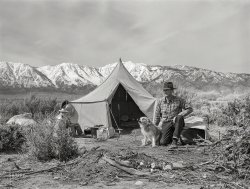
- Bodie: 1962
- ... town on the eastern slope of the Sierra Nevada between Yosemite and Tahoe, is now a state historic park.
Ron Partridge These ... Posted by Dave - 08/01/2012 - 1:32pm -
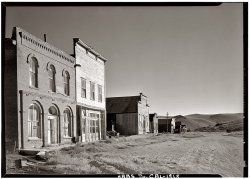
- High Sierra: 1930s
- Yosemite National Park seems to have been a favorite of this family throughout ... Posted by Tony W. - 09/17/2011 - 8:18pm -
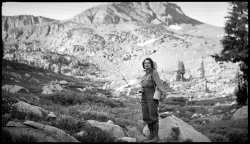
- Grand Exit: 1920
- Northern California circa 1920. "Touring car at Yosemite National Park." Our second look at the FAREWELL sign, but with a ... Posted by Dave - 03/01/2015 - 11:54am -
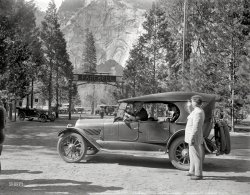
- Through the Wawona Tree: 1936
- ... family of Oakland, California began coming to Yosemite every summer in 1926. They would stay two months at a stretch. The girl, Violet, celebrated her first birthday in Yosemite, in July 1934. In July 2014, she celebrated her 81st birthday there. ... Posted by TerryCarroll - 09/05/2015 - 12:44pm -
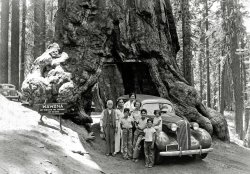
- Original Signers: 1921
- ... View full size.
Invisibility Is the painting of Yosemite on the side of the truck a 1921 form of camouflage? Or is this ... Posted by Dave - 03/17/2016 - 9:43pm -
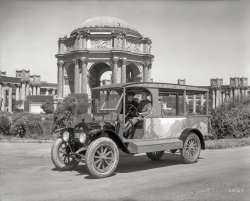
- Trunk Route: 1967
- ... on destinations none of us has visited, Sequoia NP and Yosemite NP. We're waiting for libraries to reopen so we can borrow guidebooks, ... Posted by tterrace - 04/19/2020 - 2:15pm -
![Trunk Route: 1967 My father steers our 1966 Rambler Classic station wagon through Sequoia National Park's Tunnel Log in this Kodachrome slide I took on our summer vacation in July 1967. But it wasn't the first time he'd driven a Rambler through a tree, however, an event seen previously here on Shorpy. View full size.
Ramble OnHey I think we were right behind you. Pulling a pop-up from Ohio to SF to Tijuana and back in a Rambler Rebel SS. Five of us.
I'm not that old, but almostOne of the Boy Scout dads had a Rambler like this, possibly a few years older, in the early '80s. It was red. I rode in it a couple of times. I also remember the Tunnel Log, but we didn't go there in the Rambler. There was also a Boy Scout dad who owned a red Olds Vista Cruiser.
One big thing I remember about Sequoia National Park is the bear. As my dad tells the story, they had packed all the meat for our Boy Scout camp in an old dead refrigerator, in an open U-Haul trailer. They had called ahead to the nearest ice house, and were assured that dry ice would be available. However, after we arrived, the dry ice machine had broken down, so the meat thawed, and a bear smelled it, lifted the fridge straight up out of the trailer, and threw it on the ground. The adults were banging on pots and pans, unsuccessfully trying to scare the bear away.
I, age 11, slept through it in a tent no more than 50 feet away. This was in 1980.
At least the the tree was dead.And not a novelty tree tunnel that ultimately killed the tree.
Lovely and timely photoThinking it'll be a year before a Covid-19 vaccine is available, my family, lifelong Michiganders, has started to plan a road trip. Just yesterday we settled on destinations none of us has visited, Sequoia NP and Yosemite NP. We're waiting for libraries to reopen so we can borrow guidebooks, and were happily surprised to see a photo of Tunnel Log.
Most libraries are digitalNo need to wait for a library to be open, most are digital these days. You can sign up for a library card, borrow books electronically.
[But can you "check out" the Tunnel Log? - Dave]
(ShorpyBlog, Member Gallery, tterrapix)](https://www.shorpy.com/files/images/sequoia_tunnel_log_3161_2000.thumbnail.jpg)
- Happy Campers: 1920
- ... might have looked a little out of place at Muir Woods or Yosemite.
(The Gallery, Cars, Trucks, Buses, San Francisco, W. Stanley) ... Posted by Dave - 08/13/2015 - 9:41am -
![Happy Campers: 1920 From circa 1920 comes this uncaptioned view of an early motor home taking on water at the Federal Truck agency in San Francisco. 8x10 inch nitrate negative formerly of the Marilyn Blaisdell and Wyland Stanley collections. View full size.
Door placementIf he sits there to drive, the steering wheel must be right in front of him. Does that mean you go around the front of the steering wheel to go out the door?
Rough Rider!I can't imagine riding over 1920s roads with those solid tires. No flats, but the noise from upset silverware would drive one crazy.
Dumping Ground?I had no idea there were motorhomes as long ago as 1920. Seems like inventions in those days spawned applications very fast.
Note the cylindrical tanks ranged along the side below the body -- perhaps potable water, stove fuel, and holding? The louvers in the side and no window in that area suggest that could be the bathroom.
Today's motorhomes usually have the utilities, including the dump valves, on the driver's side. I don't see anything I recognize as that in the photo. And at that time, surely there were few places with dump stations, so I wonder how you got rid of the holding tank contents? Maybe just into a ditch when no one was looking?
[If there are sanitary facilities in this rig, I suspect they are more along the lines of a chamberpot and do not involve tanks or plumbing. - Dave]
Howard StreetThe building is still there at 1350 Howard St. So is the domed building down at Howard and Ninth.
Hit the brakes!Can you imagine driving that behemoth down a hill in San Francisco when it only has drum brakes on the rear and no brakes up front? No thanks!
Awfully dapper gentto be driving that monster. Granted, life was more formal in the early 20th Century, but even then that homburg and four-in-hand might have looked a little out of place at Muir Woods or Yosemite.
(The Gallery, Cars, Trucks, Buses, San Francisco, W. Stanley)](https://www.shorpy.com/files/images/SHORPY-507-01A.thumbnail.jpg)
- Glacier Point c. 1920
- ... Glacier Point , on the south wall of California's Yosemite Valley at an elevation of 7,214 feet, 3,200 feet above Curry Village, offers superb views of Yosemite Falls, Half Dome, Vernal Falls, Nevada Falls and Clouds Rest.
... Posted by Joe - 03/04/2008 - 10:54pm -
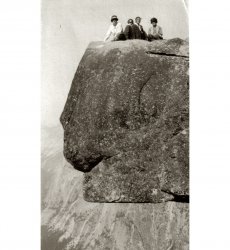
- Fresno Fulton Mall: 1967
- ... and Kings Canyon National Parks; then on the way to Yosemite we went through Fresno, where I took this Kodachrome slide of the ... Posted by tterrace - 05/17/2015 - 11:42am -
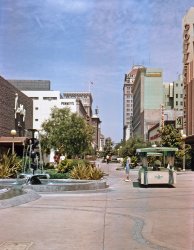
- Bill Bliss: Mid-1950s
- Here is Bill Bliss with an unknown girl in Yosemite, mid-fifties. Scanned from the 2½ x 3½ inch negative. View full ... Posted by Tony W. - 09/18/2011 - 10:02pm -
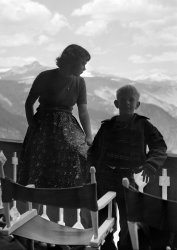
- Ex-Tourist Attraction
- Yosemite National Park, July 1962. My shot of my father maneuvering our 1956 ... Posted by tterrace - 07/31/2017 - 10:06pm -
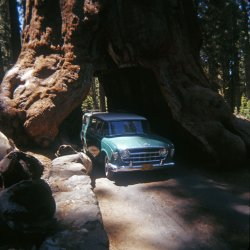
- Wawona Tree
- ... was a famous giant sequoia that stood in Mariposa Grove, Yosemite National Park. It had a height of 227 feet (69 m) and was 90 ft (27 m) ... Posted by Joe - 03/04/2008 - 2:12pm -
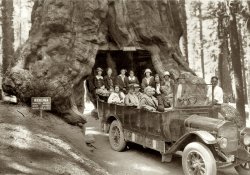
- Meandering Marmon: 1919
- California circa 1919. "Marmon touring car at Yosemite." Latest entrant in the Shorpy Concours of Discontinued Conveyances. ... Posted by Dave - 06/13/2015 - 9:02pm -
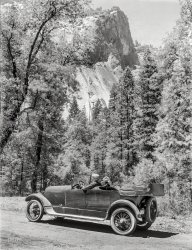
- On Vacation 1962
- ... Gold Rush town of Mariposa, California on our way to Yosemite. My mother, grandmother and father are standing at the corner of the ... Posted by tterrace - 07/31/2017 - 10:03pm -
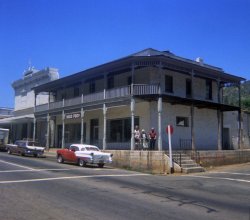
- Overheated Ford
- ... much since there are so many other pictures of the Yosemite vacation. Doing a little bit of research, it's a Mercury, likely a ... Posted by mhallack - 06/06/2009 - 6:24pm -
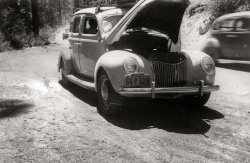
- Shipmates, USS LA Vallette: 1944
- ... were hit my father survived but spents many months at the Yosemite Naval hospital. He's in the upper left corner as your looking at it ... Posted by MJBJ - 04/21/2012 - 7:15am -
- Breakfast?: 1930s
- Some campers enjoy a meal in Yosemite park, 1930s. View full size
(ShorpyBlog, Member Gallery, ... Posted by Tony W. - 09/17/2011 - 8:23pm -
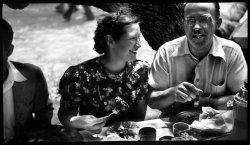
- Running Board Beauty
- ... to build their own homes and buy new cars and travel to Yosemite for vacations.
(ShorpyBlog, Member Gallery) ... Posted by Westcoaster - 08/15/2010 - 12:15am -
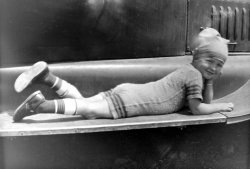
- Wawona tunnel tree, back end
- From the Yosemite trip again, this time cars are lining up and waiting to drive through ... Posted by mhallack - 09/20/2011 - 8:36pm -
